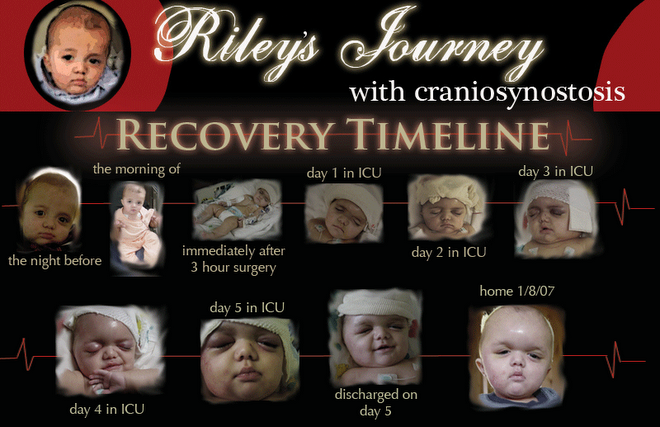
 After noticing a slight disfigurement of Riley's head, we met with a specialist who diagnosed Riley with "Craniosynostosis" and "probable Pfeiffer Syndrome".
After noticing a slight disfigurement of Riley's head, we met with a specialist who diagnosed Riley with "Craniosynostosis" and "probable Pfeiffer Syndrome".Their are 5 types of Craniosynostosis. The kind Riley has is called Unilateral Coronal Synostosis:
In unilateral coronal synostosis, the coronal suture on one side of the head fuses prematurely. This leads to a condition which specialists refer to as plagiocephaly or slanted head. In this disorder, the forehead on the involved side appears flat, and the opposite side may bulge out. The bony rim above the eye on the involved side is also flatter and may look higher than the one on the uninvolved side and the nose points away from the fused suture. An operation is necessary to allow the brain room for growth, and to restore the normal shape to the forehead. If left untreated, this condition causes a skull deformity that will get worse over time. It also causes facial disfigurement, and could in rare cases cause brain damage. Babies with unilateral coronal synostosis should see a neurosurgeon and craniofacial surgeon to plan for surgery. The goal of surgery is to open the prematurely fused suture, restore the normal shape of both the forehead and rim above the affected eye, and allow for normal brain growth. In this operation, called a "frontal-orbital advancement", the surgeon accesses the bone of the skull through an incision that goes from ear to ear across the top of the head. The surgeon removes the bones of the forehead, reshapes and advances the bone with small plates and screws that will eventually dissolve.
He was also diagnosed with probable Pfeiffer Syndrome:
Pfeiffer syndrome is a genetic disorder characterized by the premature fusion of certain bones of the skull (craniosynostosis), which prevents further growth of the skull and affects the shape of the head and face. In addition, the thumbs and big toes are broader and often shorter than normal. Many of the characteristic facial features of Pfeiffer syndrome result from the premature fusion of the skull bones. The head is unable to grow normally, which leads to bulging and wide-set eyes, an underdeveloped upper jaw, and a beaked nose. About 50 percent of children with Pfeiffer syndrome have hearing loss, and dental problems are also common. Additionally, the thumbs and big toes are broader than normal and bend away from the other digits. Unusually short fingers and toes (brachydactyly) are also common, and there may be some webbing or fusion between the digits (syndactyly). Pfeiffer syndrome affects about 1 in 100,000 individuals.
Until we see a geneticist, we will not know for sure if Riley has Pfeiffer. The craniofacial specialist did find some genetic anamolies on his body which could or could not be related to the syndrome.

No comments:
Post a Comment